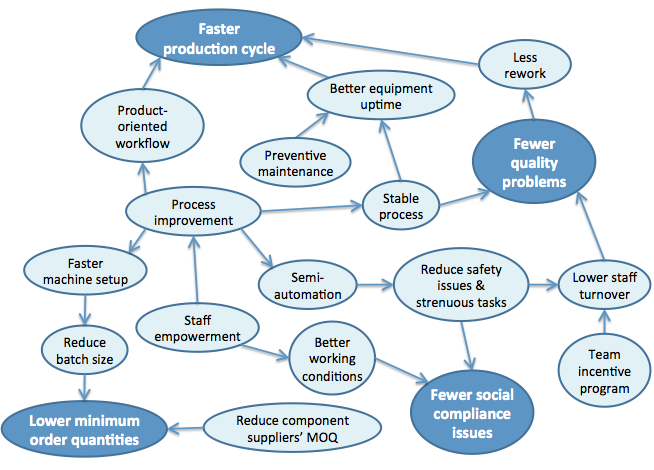 Tell Chinese manufacturers that you can help them achieve substantial reduction of costs, and they will listen. They might not believe that it is possible without applying new technologies, but at least that’s a topic they are interested in.
Tell Chinese manufacturers that you can help them achieve substantial reduction of costs, and they will listen. They might not believe that it is possible without applying new technologies, but at least that’s a topic they are interested in.
However, importers place more and more importance on quality and speed. Not to mention the need lower MOQs and fewer CSR issues. Well, a solid implementation of lean principles can help. Here are the mechanisms at play:
There are clear cause-and-effect relationships. It starts with process improvement — something Chinese factories so seldom try to do. And it works like a system, with every part reinforcing the others.
Do these benefits really exist?
I am not making it up. If you want a more precise description and quantification of the benefits of a lean turnaround, here are a couple of excepts from two excellent books on the subject.
Straight out of The Lean Turnaround (the author managed several manufacturing businesses as CEO, and turned them around completely):
My experience, and that of many others, would suggest that for manufacturing companies, you could achieve, at the least, the following results:
– Lead times cut from weeks to days.
– Inventory turns doubled in two years and quadrupled in four.
– Annual productivity gains of 15 to 20 percent.
– A 50 percent reduction in floor space in two years.
– A 4 to 8 percent improvement in gross margins.
– Working capital as a percentage of sales cut in half.
– Increased growth by taking market share.
– The creation of a team culture in which each person can learn and create personal wealth.
And the authors (academics who have visited and helped many manufacturers) of Lean Thinking are even more positive regarding the short-term benefits:
Based on years of benchmarking and observation in organizations around the world, we have developed the following simple rules of thumb: converting a classic batch-and-queue production system to continuous flow with effective pull by the customer will double labor productivity all the way through the system (for direct, managerial, and technical workers, from raw materials to delivered product) while cutting production throughput times by 90 percent and reducing inventories in the system by 90 percent as well. Errors reaching the customer and scrap within the production process are typically cut in half, as are job-related injuries. Time-to-market for new products will be halved and a wider variety of products, within product families, can be offered at very modest additional cost. What’s more, the capital investments required will be very modest, even negative, if facilities and equipment can be freed up and sold.
And this is just to get started. This is the kaikaku bonus released by the initial, radical realignment of the value stream. What follows is continuous improvements by means of kaizen en route to perfection. Firms having completed the initial realignment can typically double productivity again through incremental improvements within two to three years and halve again inventories, errors, and lead times during this period. And then the combination of kaikaku and kaizen can produce endless improvements.
Are such levels of improvement realistic?
Yes, I think these numbers can apply to a typical exporting Chinese factory, under certain conditions:
- Customers will understand the general principle, and give a higher number of smaller orders (optimizing the whole system rather than transportation costs in isolation from production).
- The management style can evolve slowly from “very oppressive” in the direction of “empowering”. This is a challenge in many workshops.
- The boss is strongly in favor of the transformation, and does not get discouraged at the first setback.
Is achieving such impressive results possible in any type of organization?
- It is easier in service operations, as well as in simple assembly-type manufacturing operations.
- When huge machines are involved, it takes more work but it is still feasible. The key is to get all the setup times down. Over time, they should all come below 10 minutes. If you have an interest in this topic, watch this video after the 25:08 and the 29:48 marks.
What do you think?

